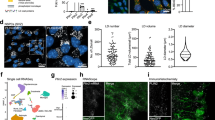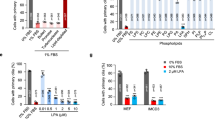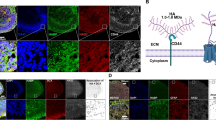Abstract
Lysophosphatidic acid (LPA) is a phospholipid that has extracellular signaling properties mediated by G protein–coupled receptors. Two LPA receptors, LPA1 and LPA2, are expressed in the embryonic cerebral cortex, suggesting roles for LPA signaling in cortical formation. Here we report that intact cerebral cortices exposed to extracellular LPA ex vivo rapidly increased in width and produced folds resembling gyri, which are not normally present in mouse brains and are absent in LPA1 LPA2 double-null mice. Mechanistically, growth was not due to increased proliferation but rather to receptor-dependent reduced cell death and increased terminal mitosis of neural progenitor cells (NPCs). Our results implicate extracellular lipid signals as new influences on brain formation during embryonic development.
This is a preview of subscription content, access via your institution
Access options
Subscribe to this journal
Receive 12 print issues and online access
$209.00 per year
only $17.42 per issue
Buy this article
- Purchase on Springer Link
- Instant access to full article PDF
Prices may be subject to local taxes which are calculated during checkout








Similar content being viewed by others
References
Rakic, P. A small step for the cell, a giant leap for mankind: a hypothesis of neocortical expansion during evolution. Trends Neurosci. 18, 383–388 (1995).
Caviness, V.S. Jr., Takahashi, T. & Nowakowski, R.S. Numbers, time and neocortical neuronogenesis: a general developmental and evolutionary model. Trends Neurosci. 18, 379–383 (1995).
Haydar, T.F., Kuan, C.Y., Flavell, R.A. & Rakic, P. The role of cell death in regulating the size and shape of the mammalian forebrain. Cereb. Cortex 9, 621–626 (1999).
Pompeiano, M., Blaschke, A.J., Flavell, R.A., Srinivasan, A. & Chun, J. Decreased apoptosis in proliferative and postmitotic regions of the caspase 3–deficient embryonic central nervous system. J. Comp. Neurol. 423, 1–12 (2000).
LoTurco, J.J., Owens, D.F., Heath, M.J., Davis, M.B. & Kriegstein, A.R. GABA and glutamate depolarize cortical progenitor cells and inhibit DNA synthesis. Neuron 15, 1287–1298 (1995).
Drago, J., Murphy, M., Carroll, S.M., Harvey, R.P. & Bartlett, P.F. Fibroblast growth factor–mediated proliferation of central nervous system precursors depends on endogenous production of insulin-like growth factor I. Proc. Natl. Acad. Sci. USA 88, 2199–2203 (1991).
Ghosh, A. & Greenberg, M.E. Distinct roles for bFGF and NT-3 in the regulation of cortical neurogenesis. Neuron 15, 89–103 (1995).
Temple, S. & Qian, X. bFGF, neurotrophins and the control of cortical neurogenesis. Neuron 15, 249–252 (1995).
Vaccarino, F.M. et al. Changes in cerebral cortex size are governed by fibroblast growth factor during embryogenesis. Nat. Neurosci. 2, 246–253 (1999).
Suh, J., Lu, N., Nicot, A., Tatsuno, I. & DiCicco-Bloom, E. PACAP is an anti-mitogenic signal in developing cerebral cortex. Nat. Neurosci. 4, 123–124 (2001).
Fukushima, N., Ishii, I., Contos, J.J., Weiner, J.A. & Chun, J. Lysophospholipid receptors. Annu. Rev. Pharmacol. Toxicol. 41, 507–534 (2001).
Chun, J. et al. International union of pharmacology. XXXIV. Lysophospholipid receptor nomenclature. Pharmacol. Rev. 54, 265–269 (2002).
Contos, J.J. & Chun, J. The mouse lp A3 /Edg7 lysophosphatidic acid receptor gene: genomic structure, chromosomal localization, and expression pattern. Gene 267, 243–253 (2001).
Hecht, J.H., Weiner, J.A., Post, S.R. & Chun, J. Ventricular zone gene-1 (vzg-1) encodes a lysophosphatidic acid receptor expressed in neurogenic regions of the developing cerebral cortex. J. Cell. Biol. 135, 1071–1083 (1996).
McGiffert, C., Contos, J.J., Friedman, B. & Chun, J. Embryonic brain expression analysis of lysophospholipid receptor genes suggests roles for s1p 1 in neurogenesis and s1p 1–3 in angiogenesis. FEBS Lett. 531, 103–108 (2002).
Dubin, A.E., Bahnson, T., Weiner, J.A., Fukushima, N. & Chun, J. Lysophosphatidic acid stimulates neurotransmitter-like conductance changes that precede GABA and L-glutamate in early, presumptive cortical neuroblasts. J. Neurosci. 19, 1371–1381 (1999).
Fukushima, N., Weiner, J.A. & Chun, J. Lysophosphatidic acid (LPA) is a novel extracellular regulator of cortical neuroblast morphology. Dev. Biol. 228, 6–18 (2000).
Contos, J.J., Fukushima, N., Weiner, J.A., Kaushal, D. & Chun, J. Requirement for the lp A1 lysophosphatidic acid receptor gene in normal suckling behavior. Proc. Natl. Acad. Sci. USA 97, 13384–13389 (2000).
Contos, J.J. et al. Characterization of lpa 2 (Edg4) and lpa 1 /lpa 2 (Edg2/Edg4) lysophosphatidic acid receptor knockout mice: signaling deficits without obvious phenotypic abnormality attributable to lpa 2 . Mol. Cell Biol. 22, 6921–6929 (2002).
Sauer, F. Mitosis in the neural tube. J. Comp. Neurol. 62, 377–405 (1935).
Sidman, R.L., Miale, I.L. & Feder, N. Cell proliferation and migration in the primitive ependymal zone: an autoradiographic study of histogenesis in the nervous system. Exp. Neurol. 1, 322–333 (1959).
Hendzel, M.J. et al. Mitosis-specific phosphorylation of histone H3 initiates primarily within pericentromeric heterochromatin during G2 and spreads in an ordered fashion coincident with mitotic chromosome condensation. Chromosoma 106, 348–360 (1997).
Rehen, S.K. et al. Chromosomal variation in neurons of the developing and adult mammalian nervous system. Proc. Natl. Acad. Sci. USA 98, 13361–13366 (2001).
Takahashi, T., Nowakowski, R.S. & Caviness, V.S. Jr. Cell cycle parameters and patterns of nuclear movement in the neocortical proliferative zone of the fetal mouse. J. Neurosci. 13, 820–833 (1993).
Takahashi, T., Nowakowski, R.S. & Caviness, V.S., Jr. The cell cycle of the pseudostratified ventricular epithelium of the embryonic murine cerebral wall. J. Neurosci. 15, 6046–6057 (1995).
Cai, L., Hayes, N.L. & Nowakowski, R.S. Local homogeneity of cell cycle length in developing mouse cortex. J. Neurosci. 17, 2079–2087 (1997).
Moolenaar, W.H. Lysophosphatidic acid signalling. Curr. Opin. Cell Biol. 7, 203–210 (1995).
Menezes, J.R. & Luskin, M.B. Expression of neuron-specific tubulin defines a novel population in the proliferative layers of the developing telencephalon. J. Neurosci. 14, 5399–5416 (1994).
Ye, X., Ishii, I., Kingsbury, M.A. & Chun, J. Lysophosphatidic acid as a novel cell survival/apoptotic factor. Biochim. Biophys. Acta. 1585, 108–113 (2002).
Blaschke, A.J., Staley, K. & Chun, J. Widespread programmed cell death in proliferative and postmitotic regions of the fetal cerebral cortex. Development 122, 1165–1174 (1996).
Blaschke, A.J., Weiner, J.A. & Chun, J. Programmed cell death is a universal feature of embryonic and postnatal neuroproliferative regions throughout the central nervous system. J. Comp. Neurol. 396, 39–50 (1998).
Ishii, I., Contos, J.J., Fukushima, N. & Chun, J. Functional comparisons of the lysophosphatidic acid receptors, LPA1/VZG-1/EDG-2, LPA2/EDG-4, and LPA3/EDG-7 in neuronal cell lines using a retrovirus expression system. Mol. Pharmacol. 58, 895–902 (2000).
Kuida, K. et al. Decreased apoptosis in the brain and premature lethality in CPP32-deficient mice. Nature 384, 368–372 (1996).
Chenn, A. & Walsh, C.A. Regulation of cerebral cortical size by control of cell cycle exit in neural precursors. Science 297, 365–369 (2002).
Ishii, I., Fukushima, N., Ye, X. & Chun, J. Lysophospholipid receptors: signaling and biology. Annu. Rev. Biochem. (in press).
Fukushima, N. et al. Lysophosphatidic acid influences the morphology and motility of young, postmitotic cortical neurons. Mol. Cell Neurosci. 20, 271–282 (2002).
Jalink, K., Eichholtz, T., Postma, F.R., van Corven, E.J. & Moolenaar, W.H. Lysophosphatidic acid induces neuronal shape changes via a novel, receptor-mediated signaling pathway: similarity to thrombin action. Cell Growth Differ. 4, 247–255 (1993).
Umezu-Goto, M. et al. Autotaxin has lysophospholipase D activity leading to tumor cell growth and motility by lysophosphatidic acid production. J. Cell. Biol. 158, 227–233 (2002).
Tokumura, A. et al. Identification of human plasma lysophospholipase D, a lysophosphatidic acid–producing enzyme, as autotaxin, a multifunctional phosphodiesterase. J. Biol. Chem. 277, 39436–39442 (2002).
Brauer, A.U. et al. A new phospholipid phosphatase, PRG-1, is involved in axon growth and regenerative sprouting. Nat. Neurosci. 6, 572–578 (2003).
Thomaidou, D., Mione, M.C., Cavanagh, J.F. & Parnavelas, J.G. Apoptosis and its relation to the cell cycle in the developing cerebral cortex. J. Neurosci. 17, 1075–1085 (1997).
Le Gros Clark, W.E. Deformation patterns on the cerebral cortex. in Essays on Growth and Form (eds. Le Gros Clark, W.E. & Medawar, P.B.) 1–22 (Oxford Univ. Press, London, 1945).
Richman, D.P., Stewart, R.M., Hutchinson, J.W. & Caviness, V.S. Jr. Mechanical model of brain convolutional development. Science 189, 18–21 (1975).
Barron, D.H. An experimental analysis of some factors involved in the development of fissure pattern of the cerebral cortex. J. Exp. Zool. 113, 553–573 (1950).
Gage, F.H. Mammalian neural stem cells. Science 287, 1433–1438 (2000).
Alvarez-Buylla, A., Garcia-Verdugo, J.M. & Tramontin, A.D. A unified hypothesis on the lineage of neural stem cells. Nat. Rev. Neurosci. 2, 287–293 (2001).
Mandala, S. et al. Alteration of lymphocyte trafficking by sphingosine-1-phosphate receptor agonists. Science 296, 346–349 (2002).
Fukushima, N., Kimura, Y. & Chun, J. A single receptor encoded by vzg-1/lp A1/edg-2 couples to G proteins and mediates multiple cellular responses to lysophosphatidic acid. Proc. Natl. Acad. Sci. USA 95, 6151–6156 (1998).
Takahashi, T., Nowakowski, R.S. & Caviness, V.S., Jr. Interkinetic and migratory behavior of a cohort of neocortical neurons arising in the early embryonic murine cerebral wall. J. Neurosci. 16, 5762–5776 (1996).
Rehen, S.K., Cid, M., Fragel-Madeira, L. & Linden, R. Differential effects of cyclin-dependent kinase blockers upon cell death in the developing retina. Brain Res. 947, 78–83 (2002).
Acknowledgements
The authors thank B. Friedman, D. Kaushal, M. McConnell, A. Yang, X. Ye and J. H. Brown for useful discussions regarding this work; B. Almeida, M. Fontanoz, J. Goodson and G. Kennedy for technical assistance; J. Goodson for critical reading of this manuscript; and H. Karten for assistance with photography. This work was supported by the National Institute of Mental Health and Human Frontiers Science Program (J.C.), a Neuroplasticity of Aging Training Grant postdoctoral fellowship from the National Institute of Aging (M.A.K.), a postdoctoral fellowship from the PEW Latin American Fellows in the Biomedical Sciences (S.K.R.), a predoctoral fellowship from the Howard Hughes Medical Institute and a Merck fellow award (C.M.H.) and The Helen L. Dorris Institute for the Study of Neurological and Psychiatric Disorders of Children and Adolescents (J.C., M.A.K., S.K.R., C.M.H.).
Author information
Authors and Affiliations
Corresponding author
Ethics declarations
Competing interests
The authors declare no competing financial interests.
Rights and permissions
About this article
Cite this article
Kingsbury, M., Rehen, S., Contos, J. et al. Non-proliferative effects of lysophosphatidic acid enhance cortical growth and folding. Nat Neurosci 6, 1292–1299 (2003). https://doi.org/10.1038/nn1157
Received:
Accepted:
Published:
Issue Date:
DOI: https://doi.org/10.1038/nn1157
This article is cited by
-
Lutein levels in arterial cord blood correlate with neurotrophic calcium binding S100B protein in healthy preterm and term newborns
Italian Journal of Pediatrics (2022)
-
G-protein coupled receptor, PI3K and Rho signaling pathways regulate the cascades of Tau and amyloid-β in Alzheimer’s disease
Molecular Biomedicine (2021)
-
Role of lysophosphatidic acid and its receptors in health and disease: novel therapeutic strategies
Signal Transduction and Targeted Therapy (2021)
-
Generation of an Lpar1-EGFP Fusion Knock-in Transgenic Mouse Line
Cell Biochemistry and Biophysics (2021)
-
Lysophosphatidic Acid Signalling in Nervous System Development and Function
NeuroMolecular Medicine (2021)



